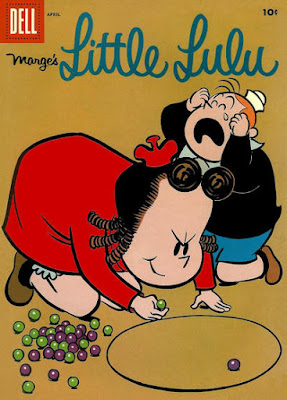Before getting to today's comic, the subtitle of this week's theme needs a bit of explanation. Back when comics were more commonly available in convenience stores, they were housed on the dreaded spinner rack - this was a convenient way of displaying the comics, but didn't do much for keeping them in the pristine condition we collectors like to see (that's sarcasm, btw). Some places still use the spinner rack, but more commonly now comics are displayed like their magazine cousins. But the top of many spinner racks looked a little like this:
Hence, our subtitle.
There are so many things that are fascinating about this comic. I've had this run of kid's comics sitting, waiting to be read, for a few months now. I'm not sure when I got this Lulu comic, but it's not in my database for some reason. I must have procured it, set it aside for a week of children's comics, and then never entered it into the collection. I'll remedy that today, though I cannot for the life of me think of where I got it.
This is one of the oldest pieces in the collection, almost 60 years young, and it really shows. The ads inside are incredible, and I learned from the back cover that the company 3M, you know, the one that makes Scotch tape and stuff, is actually called the Minnesota Mining and Manufacturing company. One day I'll compile ads from old comics into a post, and at least a couple from this comic will be included.
As I've noted a few times over the last months, I've been teaching a course on dream literature, and I wish I'd come across this comic right at the beginning of term, rather than here at the end. The opening story in this issue would have been a perfect text for the class. Lulu falls asleep (but has that Alice-esque moment of dream and reality bleeding into one another) and then starts growing and shrinking while her dolls and stuffed animals complain about not having enough room in the bed. It's obviously trading on the Alice stories, as well as McKay's Little Nemo comics. But not only does this happen to Lulu in the first story, but to Tubby in the final story, and he even goes down a rabbit hole and discovers the secret Easter Bunny egg-making factory. Both stories exhibit that same kind of uncanniness that books like Alice, or Maurice Sendak's Where the Wild Things Are, do, while also paying tribute to McKay's remarkable strip. Of course, being who I am, I can't help but see parallels to Little Ego as well, but perhaps a discussion of children's comics is not the place to bring up that particular bit of erotica.
What these interesting stories do is mask, to a certain extent, the buried mores evident in the comic. It's from 1958, remember. The cast is completely white-washed - I suppose it's better than having the usual stereotypes one finds in comics from this period (have a look at the Barks duck comics some time), but apart from one outburst from Lulu's friend Annie ("We'd fix the food, Tub!" says Lulu. To which Annie adds "That's what girls are for, silly!"), Lulu presents a remarkably independent and assertive female presence. I'm curious about the comic now, both for its stories and for its potentially forward-thinking position on gender politics. Though I'm not sure how much more Lulu I have in the collection.
Onward! Tomorrow some more contemporary children's fare.


No comments:
Post a Comment